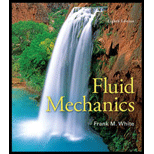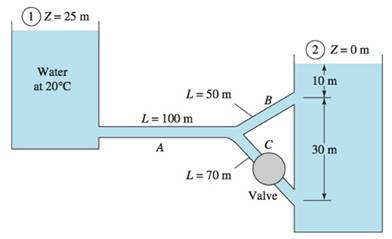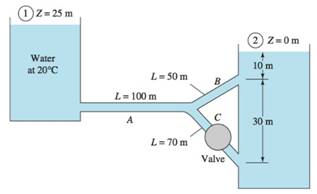
Concept explainers
(a)
The flow rate from reservoir 1 if valve C is closed.
Answer to Problem 6.115P
Explanation of Solution
Given information:

All pipes are made of cast iron and the diameter is equal to
If the valve C is closed, the energy equation for the above system can be written as,
Since, the flow is series and the diameter is same for all pipes, the flow rate and the velocity will be equal in both pipe A and pipe B.
Calculation:
Assume, the water at
The loss co efficient will be equal to,
According to the explanation, the energy equation will be,
Assume,
Therefore,
Calculate the Reynolds’s number
Calculate the roughness ratio
Calculate the exact value of friction factor
Now, calculate the exact value of the velocity
Calculate the flow rate
Conclusion:
The flow rate is equal to
(b)
The flow arte from reservoir 1 if valve C is open.
Answer to Problem 6.115P
Explanation of Solution
Given information:

All pipes are made of cast iron and the diameter is equal to
If the valve C is opened, the energy equation for the above system can be written as,
Since, the flow is parallel in pipe B and C, and the diameter is same for all pipes,
Calculation:
Assume, the water at
The loss co-efficient will be equal to,
According to the explanation, the energy equation will be,
Similarly,
But, we also know
Assume the friction factor is same for all pipe and it is equal to,
Similarly,
By solving we get,
Now find the Reynolds’s number and friction factor separately for each pipe
According to the equations,
The relevant flow rate,
Conclusion:
The flow rate in pipe A is equal to
The flow arte in pipe B is equal to
The flow arte in pipe C is equal to
Want to see more full solutions like this?
Chapter 6 Solutions
Fluid Mechanics
- Given the following information: (I found this question on the internet and was wondering what the correct answer is) Firing rate demand = 20% Fuel air ratio = 2:1 Fuel flow = 20% Minimum air flow setting = 5% What is the set point for the air flow controller? 5%B. 10%C. 25%D. 40%arrow_forward. Where is a dew point analyzer installed to measure instrument air?(I found this question on the internet and am wondering what the correct answer is) A. AB. BC. CD. Darrow_forwardThe piston at the bottom of the stroke is 0% open. Which adjustment will change the zero setting to 5% open? ( I found this sample question on the internet and was wondering what the correct answer is out of interest) A.Slide component 2 towards the pivotB. Slide component 2 away from the pivot.C. Increase spring tension using adjustment 1.D. Decrease spring tension using adjustment 1.arrow_forward
 Elements Of ElectromagneticsMechanical EngineeringISBN:9780190698614Author:Sadiku, Matthew N. O.Publisher:Oxford University Press
Elements Of ElectromagneticsMechanical EngineeringISBN:9780190698614Author:Sadiku, Matthew N. O.Publisher:Oxford University Press Mechanics of Materials (10th Edition)Mechanical EngineeringISBN:9780134319650Author:Russell C. HibbelerPublisher:PEARSON
Mechanics of Materials (10th Edition)Mechanical EngineeringISBN:9780134319650Author:Russell C. HibbelerPublisher:PEARSON Thermodynamics: An Engineering ApproachMechanical EngineeringISBN:9781259822674Author:Yunus A. Cengel Dr., Michael A. BolesPublisher:McGraw-Hill Education
Thermodynamics: An Engineering ApproachMechanical EngineeringISBN:9781259822674Author:Yunus A. Cengel Dr., Michael A. BolesPublisher:McGraw-Hill Education Control Systems EngineeringMechanical EngineeringISBN:9781118170519Author:Norman S. NisePublisher:WILEY
Control Systems EngineeringMechanical EngineeringISBN:9781118170519Author:Norman S. NisePublisher:WILEY Mechanics of Materials (MindTap Course List)Mechanical EngineeringISBN:9781337093347Author:Barry J. Goodno, James M. GerePublisher:Cengage Learning
Mechanics of Materials (MindTap Course List)Mechanical EngineeringISBN:9781337093347Author:Barry J. Goodno, James M. GerePublisher:Cengage Learning Engineering Mechanics: StaticsMechanical EngineeringISBN:9781118807330Author:James L. Meriam, L. G. Kraige, J. N. BoltonPublisher:WILEY
Engineering Mechanics: StaticsMechanical EngineeringISBN:9781118807330Author:James L. Meriam, L. G. Kraige, J. N. BoltonPublisher:WILEY





